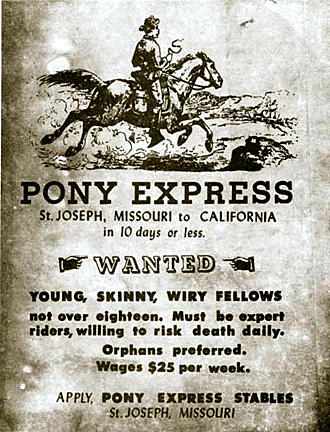 "WANTED—young,
skinny, wiry fellows, not over eighteen. Must be expert riders,
willing to risk death daily. Orphans preferred. Wages $25 a week . .
. ."
"WANTED—young,
skinny, wiry fellows, not over eighteen. Must be expert riders,
willing to risk death daily. Orphans preferred. Wages $25 a week . .
. ."
Half a million Americans lived west of the Rocky Mountains when this
notice appeared in a San Francisco paper in 1860. Two thousand miles
of mountains, plains, and deserts, broken only by Indian trails,
separated them from the rest of the United States. To link
California to the Missouri frontier, an adventurous businessman
named William Russell created the Pony Express.
A Need Arises
San Francisco had become the center of numerous mining camps after
the California gold strike in 1849. Pack mules brought in supplies,
as well as delivered three-month-old newspapers. These camps sprang
up so rapidly that the Post Office Department couldn’t keep up with
them. Tons of "dead-letter" mail piled up at the post office in San
Francisco. Eventually, enterprising men began to deliver this
unclaimed mail to such outlying places as Hog’s Glory, Murderer's
Bar, and Dead Man's Gulch by what became known as “Jackass Express.”
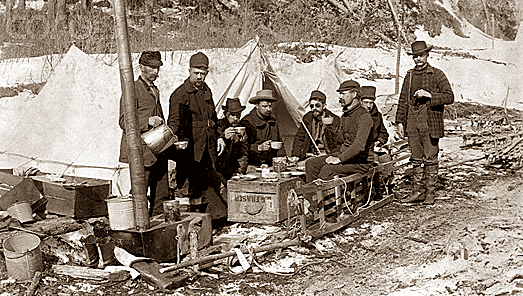
But delivering the mail nearly 2,000 miles between Missouri and
California was hazardous at best. The only way to cross the plains,
mountains and deserts to California was by horseback, covered wagon
or stagecoach. There were trails, but they couldn’t be used
throughout, and only an expert could avoid losing his way. The
rugged mountain ranges presented fatal barriers to those who didn’t
know the passes. And then there were the Indians. Even when peace
prevailed with one tribe, another one might be on the warpath. White
men who had become outlaws presented another hazard.
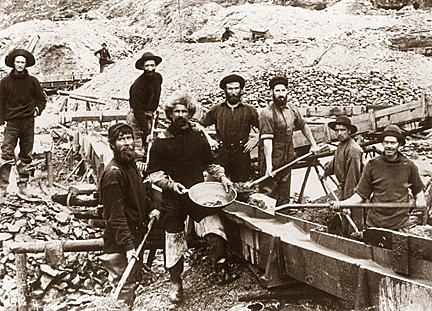 Californians
wanted to receive books, magazines and newspapers, but such mail was
too heavy and bulky to be carried by pack mules. In view of these
difficulties, it’s understandable that the Post Office sent the bulk
of the mail between California and the eastern seaboard by sea. Even
though this method was slower, it was safer. However, the company
which handled the ocean-going mail had a monopoly and charged
excessive fees.
Californians
wanted to receive books, magazines and newspapers, but such mail was
too heavy and bulky to be carried by pack mules. In view of these
difficulties, it’s understandable that the Post Office sent the bulk
of the mail between California and the eastern seaboard by sea. Even
though this method was slower, it was safer. However, the company
which handled the ocean-going mail had a monopoly and charged
excessive fees.
B. F. Ficklin, general superintendent of Central Overland California
and Pike's Peak Express Company (C.O.C. & P.P.), owned jointly by
William H. Russell, William B. Waddell, and Alexander Majors and the
largest freighting firm on the frontier, forged a plan
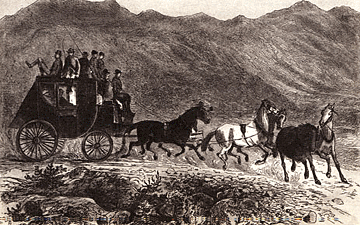 to
create faster mail delivery between Missouri and California–the Pony
Express. Russell, who was in favor of Ficklin’s idea, decided to
begin operations before receiving government support, a move that
his partners warned him against. Earlier attempts had failed
miserably. The Indian menace was more serious than ever. The winter
snows would make the trails impassable. And the Postmaster General
had said that mail delivery via the Central Overland Route was
virtually impossible.
to
create faster mail delivery between Missouri and California–the Pony
Express. Russell, who was in favor of Ficklin’s idea, decided to
begin operations before receiving government support, a move that
his partners warned him against. Earlier attempts had failed
miserably. The Indian menace was more serious than ever. The winter
snows would make the trails impassable. And the Postmaster General
had said that mail delivery via the Central Overland Route was
virtually impossible.
In their favor, the company already had an ample number of way
stations which could be used by the Pony Express. But west of Salt
Lake City, it would have to construct new stations. Each consisted
of a cabin, stable and corral, with at least two men to operate them
and guard against horse thieves.
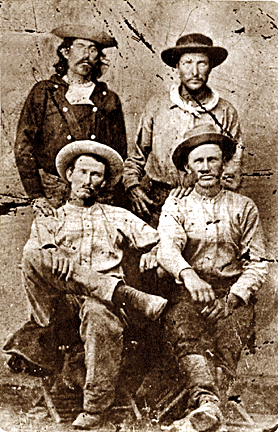 Even
though failure and sizeable losses seemed overwhelming, Russell
eventually convinced his partners to support the venture. As soon as
they announced their plans, hundreds of young applicants filled the
company’s offices despite the rigorous requirements for becoming a
Pony Express rider. Skilled horsemen and hunters, these youngsters
were no strangers to the hard life of the frontier, accustomed to
dealing with Indians, self-reliant and resourceful. Above all, the
spirit of adventure called to them.
Even
though failure and sizeable losses seemed overwhelming, Russell
eventually convinced his partners to support the venture. As soon as
they announced their plans, hundreds of young applicants filled the
company’s offices despite the rigorous requirements for becoming a
Pony Express rider. Skilled horsemen and hunters, these youngsters
were no strangers to the hard life of the frontier, accustomed to
dealing with Indians, self-reliant and resourceful. Above all, the
spirit of adventure called to them.
To outfit the Pony Express required 500 of the best American
horses–preferably California mustangs–including 190 stock stallions
for changing the riding stock, 200 station tenders to care for and
saddle the horses for the incoming rider, and 80 of the keenest,
toughest and bravest of western youths to be the riders. Stations
all had to be supplied with hay, grain and other needed materials.
It took $100,000 in gold coin to establish and equip the line. In
addition, the stations required about 400 men to ward off Indian
attacks and maintain provisions and shelter for the riders and their
mounts.
Originally, Russell proposed that the government pay him $500 per
round trip for two trips a week in both directions. But he greatly
underestimated the costs involved, which actually turned out to be
about 15 times what he had calculated. At first, mail cost $5 a half
ounce, but that was later reduced to $1.
Since the Pony Express messengers would have to depend on fast
riding to escape from Indian attack, Russell limited each animal's
load to165 pounds. This allowed 20 pounds for the mail, 25 pounds
for the equipment and 120 pounds for the rider.
Operations Begin
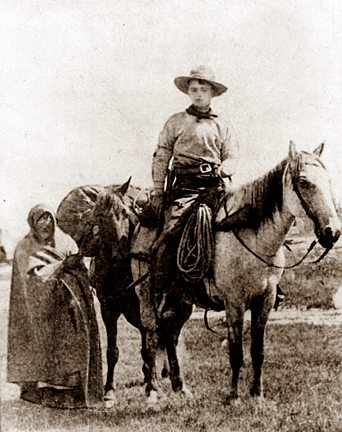 On
April 3, 1860, the Pony Express began operations when riders left
simultaneously from St. Joseph, Missouri, and Sacramento,
California. On this first trip westward from St. Joseph, on the edge
of the frontier, the Hannibal and St. Joseph Railroad delivered mail
from the East which the Pony Express would carry to California. Up
to this time, the mail had been going to St. Joseph by boat. The
westbound rider made the trip in 9 days and 23 hours while the
eastbound one made it in 11days and 12 hours. Both covered about 250
miles every 24 hours.
On
April 3, 1860, the Pony Express began operations when riders left
simultaneously from St. Joseph, Missouri, and Sacramento,
California. On this first trip westward from St. Joseph, on the edge
of the frontier, the Hannibal and St. Joseph Railroad delivered mail
from the East which the Pony Express would carry to California. Up
to this time, the mail had been going to St. Joseph by boat. The
westbound rider made the trip in 9 days and 23 hours while the
eastbound one made it in 11days and 12 hours. Both covered about 250
miles every 24 hours.
Each Pony Express rider carried a lightweight rifle and a Colt
revolver to be used strictly for defense. Russell forbid his riders
to take the offensive against Indians or other enemies. Each rider
wore a distinctive costume–a gaudy red shirt and blue pants–and
carried a horn, which he blew upon approaching a station. On hearing
the horn, the relay-station keeper and his stableman would get the
rider’s next mount ready. Every second counted, as a change of
horses wasn’t to take longer than two minutes. Riders, themselves,
changed every 75-100 miles and rode an average of 10 miles per hour,
completing the entire 1966-mile route through Kansas, Nebraska,
Colorado, Wyoming, Utah, Nevada and California in about 10 days.
Only one mail delivery was ever lost.

The Stations
Russell based the locations of the stations–150 to190 of them–on the
distance a rider and horse could normally cover without exhaustion,
an average of 10 miles. Because of this requirement, stations
weren’t always built in safe or convenient locations. Sometimes, for
example, grass and water weren’t available nearby, so it was
necessary to bring in water in barrels and drive the horses some
distance away to feed them.
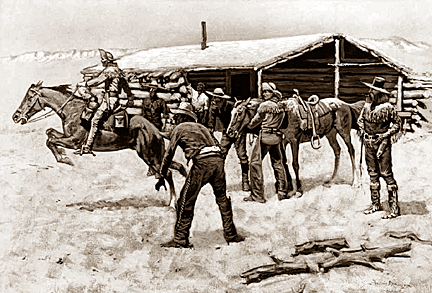 As
a rule, the home stations had already been set up earlier as
stagecoach stations. Home stations–where a rider finished his run
needed to be more elaborate. They had to provide facilities for the
riders, as well as offer the services of a blacksmith. The men who
did this work had to be top-notch in their field, for many of the
horses were half wild and needed to be held down while the
blacksmith did his work. Even so, shoeing a horse might take half a
day.
As
a rule, the home stations had already been set up earlier as
stagecoach stations. Home stations–where a rider finished his run
needed to be more elaborate. They had to provide facilities for the
riders, as well as offer the services of a blacksmith. The men who
did this work had to be top-notch in their field, for many of the
horses were half wild and needed to be held down while the
blacksmith did his work. Even so, shoeing a horse might take half a
day.
The
worst stations had dirt floors and no glass windows. Furniture
consisted of boxes and benches, with bunks built into the walls in
place of beds. Each required a large variety of supplies–hams,
bacon, flour, syrup, dried fruits, corn meal, tea and coffee, but no
alcohol. Each also had an assortment of housekeeping materials,
including hammers, saws, axes, stoves, brooms, tin dishes, tin and
wooden buckets, twine, screws, hinges, putty, candles, blankets,
matches, scissors, needles and thread, even buffalo robes and
antelope skins.
Plus each station had a well-equipped stable, filled with bridles,
rope, blacksmith's supplies, brushes, currycombs, manure forks, and
wagon grease. Borax, castor oil, cream of tartar, and turpentine
served as medicines.
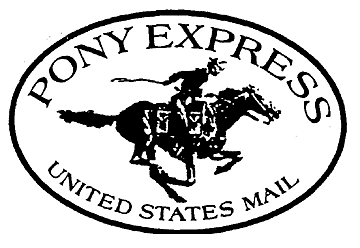 Riders
used their horns to announce their arrival in the beginning, but
soon discarded them to lighten their loads. Stationkeepers usually
listened for the sounds of the horse's hoofbeats or in daylight
watched for a large cloud of dust as a sign of a rider’s impending
arrival. As he approached, the rider would loosen his mochila, a
leather cover that fit snugly over his saddle and could be removed
easily, so that he could toss it to the keeper at the earliest
possible moment.
Riders
used their horns to announce their arrival in the beginning, but
soon discarded them to lighten their loads. Stationkeepers usually
listened for the sounds of the horse's hoofbeats or in daylight
watched for a large cloud of dust as a sign of a rider’s impending
arrival. As he approached, the rider would loosen his mochila, a
leather cover that fit snugly over his saddle and could be removed
easily, so that he could toss it to the keeper at the earliest
possible moment.
Newspapers published accounts of memorable rides, hair-raising
escapes, of quick thinking and incredible endurance, and, most of
all, loyalty and devotion of riders to their work.
Though the Pony Express lasted for only 19 months to October 24,
1861 when the Pacific Telegraph Line ended its need for existence,
there’s no equal in American history for its heroic endurance. It’s
founders had invested $700,000 and ended up bankrupt with a $200,000
deficit. They never did get the government mail contract and
eventually lost their company at auction to Ben Holladay, who sold
it to Wells Fargo for $2 million. To this day, the Pony Express
remains a symbol of swift service, the spirit of adventure and
faithful execution of an exacting and dangerous task.
